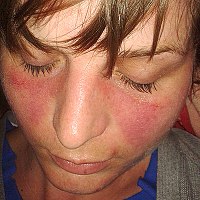
Photo from wikipedia
Although deposits of complement factors in a kidney biopsy are typical of lupus nephritis, their prognostic relevance had never been investigated until a year ago. Then, around the same time,… Click to show full abstract
Although deposits of complement factors in a kidney biopsy are typical of lupus nephritis, their prognostic relevance had never been investigated until a year ago. Then, around the same time, Kim and colleagues published a study in which deposits were associated with loss of renal function, while we published a similar study that reported no such association. Here, we explore possible explanations for these seemingly conflicting findings. Both studies assumed that deposits of C1q with or without C3 in glomeruli reflect activation of the classical pathway and that deposits of C3 without C1q in glomeruli reflect activation of only the alternative pathway of complement. Here, we refer to such patterns of deposits in short as classical and alternative deposits, respectively. Both studies compared clinical and histopathological characteristics between patients with classical deposits and those with alternative deposits (table 1). Alternative deposits were found in a minority of similar sizes in both studies. In both studies, patients with alternative deposits had less active disease based on higher serum levels of C3 and C4, a lower disease activity index and a lower pathological activity index, while organ damage was similar between groups. Kim and colleagues found that the estimated glomerular filtration rate (eGFR) remained stable in patients with classical deposits, but declined in those with alternative deposits, also when adjusted for other characteristics. We found that eGFR improved in patients with classical deposits but remained stable in those with alternative deposits. Incidences of endstage renal disease did not differ between groups in both studies. Both studies failed to explain why patients with alternative deposits had less active but more progressive disease than those with classical deposits. They would be expected to have more active disease, given that lupus is more active and more progressive if the alternative pathway is activated in the circulation. We suggest two possible explanations. First, deposits of complement factors detected by immunohistochemical staining need not reflect ongoing activity of circulating complement factors, whereas C1q binds tissue noncovalently, C3 binds tissue covalently and probably remains deposited for longer than C1q and for longer than the alternative pathway is activated. Correspondingly, both studies almost never found deposits of C1q without C3. This may explain why lupus was less active, more chronic and of slightly longer duration in patients with alternative deposits, thus with persistence of C3. Remaining deposits of C3 can sustain glomerular inflammation, which may explain the lack of improvement in eGFR despite lower disease activity in patients with alternative deposits. Second, additional deposits of C3 without C1q can be formed if the alternative pathway continues to be autonomously active after activity of the classical pathway has waned. This possibly occurs in a subset of susceptible patients, similar to diseases like C3 glomerulopathy and the atypical haemolytic uremic syndrome. This may explain why lupus was less active and of slightly longer duration, while kidney function was still lost in patients with deposits of only C3. When assuming Correspondence
Journal Title: Journal of Clinical Pathology
Year Published: 2021
Link to full text (if available)
Share on Social Media: Sign Up to like & get
recommendations!